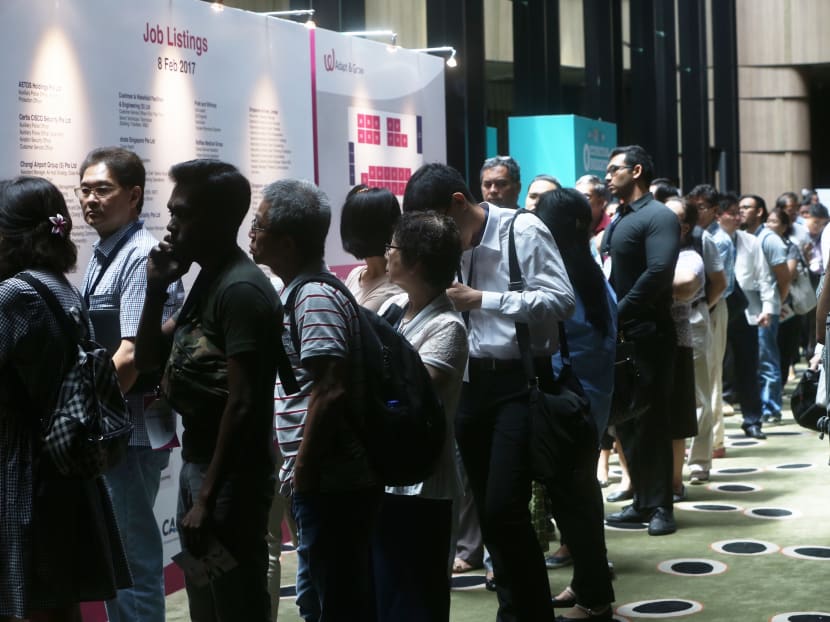Resident jobless rate rises to 3% as vacancies hit 4-year low
SINGAPORE — The job market situation has deteriorated, with the number of vacancies falling while the pool of workers laid off continues to rise.

A long queue of people waiting to enter the Adapt And Grow job fair at Crowne Plaza Changi Airport, where more than 2,300 jobs at Changi Airport are looking to be filled. Photo: TODAY
SINGAPORE — The job market situation has deteriorated, with the number of vacancies falling while the pool of workers laid off continues to rise.
The Ministry of Manpower's (MOM) 2016 labour market report released yesterday showed that seasonally adjusted job vacancies have hit a four-year low - dropping to 47,600 in December last year, down from 50,800 at the end of the third quarter. Between the third and fourth quarters, redundancies spiked from 4,220 to 5,440.
There were 77 jobs for every 100 job-seekers at the end of the fourth quarter, the third straight quarter in which the number of job-seekers outnumbered the openings available. It was also the worst ratio since September 2009, when the world was still reeling from the financial crisis. The number of layoffs reached 19,170 for the whole of last year, 23 per cent higher than the 2015 figure of 15,580.
Meanwhile, the annual average unemployment rate for citizens and permanent residents climbed to 3 per cent last year, after hovering around 2.8 per cent for four years. The rise was particularly pronounced among those aged between 30 and 39, and 50 and above. Professionals, managers, executives and technicians remained more susceptible to layoffs than other occupational groups. They formed nearly six in 10 (56.8 per cent) of all job redundancies last year.
More job-seekers were also taking a longer time to land jobs: The annual average resident long-term unemployment rate - which refers to those jobless for at least 25 weeks - edged up to 0.8 per cent last year, from 0.6 per cent in 2015. Among degree-holders, the long-term unemployment rate was 1 per cent, the highest since 2004.
On the wage front, the nominal median income - including employer Central Provident Fund contributions - of full-time employed citizens stood at S$3,823 last year, slightly higher than 2015's S$3,798. After adjusting for negative inflation, median income rose by 1.3 per cent in real terms.
Economists told TODAY that the sluggish jobs situation was not an anomaly, given the slow economic conditions in the past few years that have put a drag on hiring. Hiring could pick up pace from the second half of this year, they said.
United Overseas Bank economist Francis Tan said the economic climate has led employers to cut back on labour and keep workers on their payroll to a "bare minimum". Still, he expects the labour-market slump to bottom out and the number of vacancies to pick up in the second half of the year.
Nevertheless, DBS Bank senior economist Irvin Seah said he did not foresee layoffs coming in so high.
"I was expecting redundancies at about 18,000 … (but) it's part and parcel of restructuring," he said, noting also the cyclical factors weighing down on the economy.
Excluding foreign domestic workers, the total number of people in employment grew by 8,600 last year, compared with 23,300 in 2015. This was the slowest growth since 2003.
Although the number of Singaporeans and PRs in employment expanded by 11,200 last year, up from 700 in 2015, the increase was significantly slower than the levels seen between 2012 and 2014. Foreign employment (excluding foreign domestic workers) shrank for the first time since 2009 on the back of a continued tightening of the supply of imported labour, with work-permit holders in manufacturing, marine and construction accounting largely for the dip.
Manpower Minister Lim Swee Say had said last month that Singapore will strive for yearly employment growth of between 25,000 and 40,000 in the next three to five years.
The economists agreed that this was a "realistic" target, with CIMB Private Banking economist Song Seng Wun saying that this hinged on how far the global economy rebounds.
Mr Seah noted that the economy was in the initial phases of a turnaround, although the recovery has been uneven, with some sectors faring better than others.
The turnaround in the labour market would be "more pronounced" in the later half of the year, he reiterated, as employers need time to start hiring again when orders gather pace.
Mr Song noted tentative signs of a recovery in sectors such as hospitality and finance, but said the extent of the rebound would hinge on factors such as stronger tourist arrivals and spending in the coming months.
While the Republic was not "out of the woods" yet, he said that barring geo-political risks, such as moves by the administration of Mr Donald Trump in the United States, layoffs should be "far fewer this year and hiring should pick up pace going into 2018". In line with the Government's economic growth forecast of 1 to 3 per cent this year, the MOM said labour demand was expected to stay modest.








